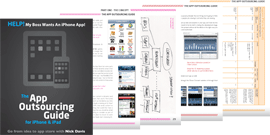As well as each iPhone (iPhone > iPhone 3G > iPhone 3GS > iPhone 4) becoming progressively faster (one point to consider when developing a high-end app, such as a 3D game, that may function poorly on older devices).There are also some small differences on how they behave which you might need to consider.
Original iPhones and the iPhone 3G (even if upgraded by the owner to the latest version of Apple’s in-phone operating system) cannot support the ‘multi-tasking’ feature released by Apple as part of it’s iOS 4 upgrade in 2010. If multi-tasking is going to be an essential part of your app then you should be aware that some of your potential users might be excluded.
Even if you’re only focusing on iPhones at present and don’t have any iPad plans, you still need to consider iPad, at least briefly, too. As, whether intended for iPad or not, all apps on the App Store can also be downloaded and used on iPads too.
What does this mean if you’ve only planned to create an app for iPhone? Well, you will not have failed to notice that an iPad has a much larger screen than an iPhone. If you haven’t used an iPad before though you may not be aware that many iPhone apps will not necessarily have been built to automatically scale to that larger screen size without suffering some loss in the quality of its appearance (imagine your iPhone App ‘stretching’ to fill that larger space).
When iPad users are viewing an app that was designed purely for an iPhone then, they have two choices:
- View it at the original size.This means your app will look sharp but of course there will be a big black space around the edges of your app where the iPad’s screen is larger.
- View it at double ‘x2’ size.This will blow up the app so it is bigger but – with many apps not yet designed to take advantage of an iPad’s bigger screen size – this will result in a ‘stretched’ view which may result in ‘pixelated’ fonts, images etc.
You may be happy to live with this for now, but with the number of iPad users growing fast it may be something that you want to consider sooner rather than later. Luckily though you have a few choices:
- Your first option, as mentioned, is to just release your regular iPhone app and let iPad users live with any ‘upscaling’;
- Release a ‘Universal App’ (optimised for iPad users).You will have seen these on the App Store marked with a small ‘+’ icon (you developer should be able to tell you more about these).This will involve more work (how much depends on how different you want your iPad App to be from your ‘standard’ iPhone App) but will give those on iPad a much better experience. (Read Apple’s Introduction to Universal Apps for more information: devimages.apple.com/iphone/resources/introductiontouniversalapps.pdf)
- Finally , you could launch a completely separate app for your iPad users. You can even price thi separately to reflect this ‘upscaled’ experience. Angry Birds creator Rovio did this and launched a $4.99 iPad version of Angry Birds (the iPhone version retails at $0.99).
